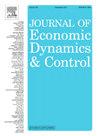劳动力市场活力下降的技术根源
IF 2.3
3区 经济学
Q2 ECONOMICS
引用次数: 0
摘要
在过去几十年中,失业与就业之间的岗位流动明显减少。我们要问的是,技术变革能否以及如何解释劳动力市场活力的长期下降。我们提出的理论侧重于广义技术的决定因素:1.工人技能与企业生产力之间的互补性;2.生产力冲击的波动性;3.搜索摩擦。我们在一个具有搜索摩擦的分拣模型中推导出了就业流,并推导出了在职和离职的内生搜索努力,以及导致不匹配的冲击。我们利用美国的数据对模型进行了量化,发现劳动力与技术之间的互补性增强了,生产率冲击的频率和波动性下降了,匹配效率下降了,搜索成本增加了。这些技术特征的变化导致了劳动力市场活力的长期下降。本文章由计算机程序翻译,如有差异,请以英文原文为准。
The technological origins of the decline in labor market dynamism
In the last decades, there has been a marked decline in the job flows to and from unemployment and between employment. We ask whether and how technological change can account for his secular decline in labor market dynamism. We propose a theory that focuses on the determinants of technology broadly defined: 1. the complementarity between worker skill and firm productivity; and 2. the volatility in productivity shocks; and 3. search frictions. We derive job flows in a sorting model with search frictions and endogenous search effort both on and off the job, as well as shocks that lead to mismatch. We quantify our model using the US data and find an increase in the complementarity between labor and technology, a decline in the frequency and volatility of productivity shocks, and a decline in the match efficiency as well as an increase in the search costs. The changing nature of these features of the technology contributes to the secular decline in labor market dynamism.
求助全文
通过发布文献求助,成功后即可免费获取论文全文。
去求助
来源期刊

Journal of Economic Dynamics & Control
ECONOMICS-
CiteScore
3.10
自引率
10.50%
发文量
199
期刊介绍:
The journal provides an outlet for publication of research concerning all theoretical and empirical aspects of economic dynamics and control as well as the development and use of computational methods in economics and finance. Contributions regarding computational methods may include, but are not restricted to, artificial intelligence, databases, decision support systems, genetic algorithms, modelling languages, neural networks, numerical algorithms for optimization, control and equilibria, parallel computing and qualitative reasoning.
 求助内容:
求助内容: 应助结果提醒方式:
应助结果提醒方式:


